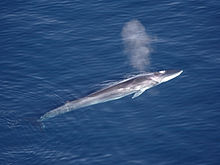| Fin whale[1] Temporal range:
| |
|---|---|

| |
| A fin whale surfacing in Greenland | |

| |
| Size compared to an average human | |
| Scientific classification | |
| Domain: | Eukaryota |
| Kingdom: | Animalia |
| Phylum: | Chordata |
| Class: | Mammalia |
| Order: | Artiodactyla |
| Infraorder: | Cetacea |
| Family: | Balaenopteridae |
| Genus: | Balaenoptera |
| Species: | B. physalus
|
| Binomial name | |
| Balaenoptera physalus | |
| Subspecies | |
| |

| |
| Fin whale range | |
| Synonyms | |
|
List
| |
The fin whale (Balaenoptera physalus), also known as the finback whale or common rorqual, is a species of baleen whale and the second-longest cetacean after the blue whale. The biggest individual reportedly measured 26 m (85 ft) in length, with a maximum recorded weight of 77 to 81 tonnes. The fin whale's body is long, slender and brownish-gray in color, with a paler underside to appear less conspicuous from below (countershading).
At least two recognized subspecies exist, one in the North Atlantic and one across the Southern Hemisphere. It is found in all the major oceans, from polar to tropical waters, though it is absent only from waters close to the pack ice at the poles and relatively small areas of water away from the open ocean. The highest population density occurs in temperate and cool waters. Its prey mainly consists of smaller schooling fish, small squid, or crustaceans, including copepods and krill. Mating takes place in temperate, low-latitude seas during the winter. Fin whales are often observed in pods of 6–10 animals, with whom they communicate utilizing frequency-modulated sounds, ranging from 16 to 40 hertz.
Like all other large whales, the fin whale was a prized kill during the "heyday" of whaling, from 1840 to 1861. It remained so into the 20th century but decades of over harvesting contributed to declining numbers through the late 20th century. Over 725,000 fin whales were reportedly taken from the Southern Hemisphere between 1905 and 1976. Post-recovery numbers of the southern subspecies are predicted to be less than 50% of the pre-whaling population, even by 2100, due to long-lasting impacts of whaling and slow recovery rates. As of 2018, it was assessed as vulnerable by the IUCN.[3]
- ^ Mead, J. G.; Brownell, R. L. Jr. (2005). "Order Cetacea". In Wilson, D. E.; Reeder, D. M. (eds.). Mammal Species of the World: A Taxonomic and Geographic Reference (3rd ed.). Johns Hopkins University Press. p. 725. ISBN 978-0-8018-8221-0. OCLC 62265494.
- ^ Tsai, C.-H.; Boessenecker, R.W. (2017). "The earliest-known fin whale, Balaenoptera physalus, from the Early Pleistocene of Northern California, U.S.A.". Journal of Vertebrate Paleontology. 37 (2). e1306536. doi:10.1080/02724634.2017.1306536.
- ^ a b Cooke, J.G. (2018). "Balaenoptera physalus". IUCN Red List of Threatened Species. 2018: e.T2478A50349982. doi:10.2305/IUCN.UK.2018-2.RLTS.T2478A50349982.en. Retrieved 19 November 2021.
- ^ "Appendices | CITES". cites.org. Archived from the original on 7 May 2022. Retrieved 14 January 2022.
- ^ Fischer, Johann Baptist (1829). Synopsis Mammalium. p. 525. Archived from the original on 6 May 2016. Retrieved 28 November 2015.
- ^ Hist. Nat. Gén. et Partie, des Mamm. et Oiseaux découverts depuis 1788 Archived 23 June 2016 at the Wayback Machine
- ^ Dewhurst, H. W. (Henry William) (1834). The natural history of the order Cetacea, and the oceanic inhabitants of the Arctic regions. Oxford University. London, Published by the author. p. 101.
- ^ Académie Royale Des Sciences, des Lettres et des Beaux-Arts de Belgique (Bruxelles) (1859). Bulletins de l'Académie Royale des Sciences, des Lettres et des Beaux-Arts. Hayez. p. 403. ISBN 9781013223624. Archived from the original on 10 June 2016. Retrieved 28 November 2015.
